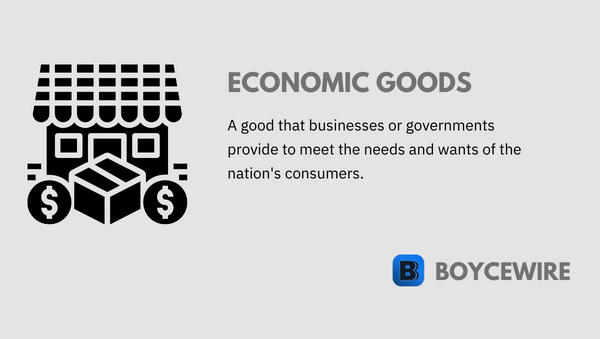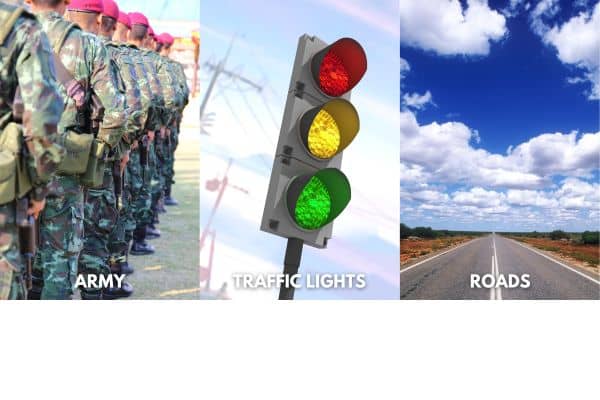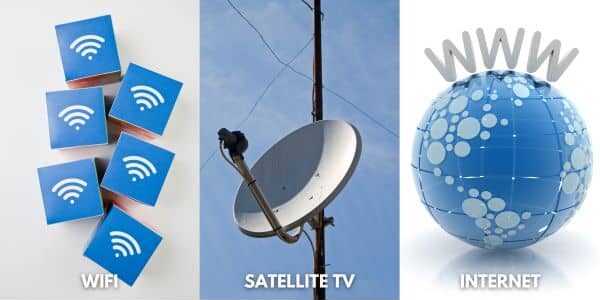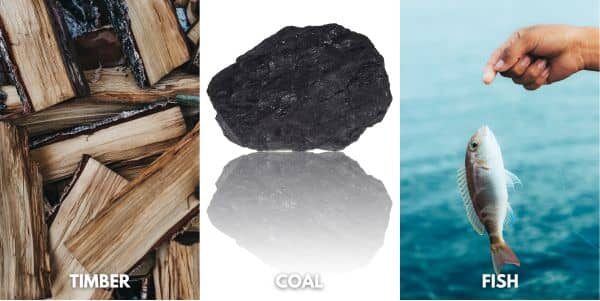Economic Goods: Definition, Types & Examples

What are Economic Goods?
An economic good is a product or service that businesses provide to meet the needs and wants of consumers. For instance, when we want to purchase something, we go to the store, or log in online and exchange money for it. So an economic good is any good or service by which we exchange resources in the form of money or labour.
To put it another way, an economic good is where a product or service can be sold at a price – either to a business, individual, government, or other organization.
It is important to note that economic goods are scarce, which is why they are ‘economic’ goods. We have to economize these resources for their best use. In the modern world, we use prices as a way to determine this. Those prices are partially determined by the labour involved to make it, but more importantly, the price the consumer is willing to paid after it is produced. This contrasts with ‘free goods’, which are abundant in supply and therefore cannot command a price. For instance, air and seawater.
Key Points
- An economic good is a good that businesses or governments provide in order to meet the demands of consumers and citizens.
- There are four main types of economic goods: private, public, club, and common.
- Economic goods are characterised by how rivalrous they are and whether they are excludable or not.
The 4 Types of Economic Goods
There are four types of economic goods that are characterised within four variables as illustrated below. They are; non-rivalrous, rivalrous, non-excludable, and excludable.

Copyright: Boycewire.com
First of all, goods can be rivalrous. If we look at the definition of ‘rival’, it means to compete against another for the desired outcome. So rivalrous goods can be defined as a competition between two or more parties for the same goods. In other words, the more person consumes, the less is available to another.
Second of all, goods can be excludable. If we look at the definition of ‘excluded’, it means to ‘shut out’ or ‘keep out’ people. So excludable goods are goods that can be shut out to the consumer. For instance, by price or physical restrictions.
1. Private Goods
Private goods are defined as both rivalrous and excludable. In other words, the seller is able to prevent consumers from accessing the product. This is most generally done through a price barrier. For example, we may have to pay $10 for a new t-shirt, $5 for a burger, or $500 for a new fridge. The customer is prevented from using the good by pricing.
- Excludable This contrasts with public goods, which are non-excludable. For example, when the government provides policing services, it is unable to prevent those who do not pay from benefiting. Private goods are characterised by the opposite, as the provider is able to prevent those who do not pay from benefiting.
- Rivalrous
Private goods are also rivalrous. This means that when one customer purchases and consumes a product, there is consequently less for others. For example, when you go into the bakery to buy a doughnut, there is then one less available to the next customer.
This contrasts with club goods, which are non-rivalrous. For example, satellite TV is non-rivalrous. If one consumer watches one channel, it doesn’t prevent other viewers from watching it. Private goods contrast with this in the fact that the supply of the good is depleted after each customer consumes the goods.

Examples of Private Goods
- Food
- Clothes
- Cars
- Fridges
- Watches
- Consumer goods
2. Public Goods
Public goods are characterised by two factors. First of all, they are non-excludable, meaning we cannot reasonably prevent others for using the good. Second of all, they are also non-rivalrous, meaning the production of the good is not competitive. In other words, businesses are not competing to sell it.
- Non-Excludable
Public goods are non-excludable in the fact that consumers cannot be prevented from accessing the good. For instance, traffic lights work for every driver that goes past. We cannot stop certain drivers from being able to use them, at least not practically. The most obvious solution would be to stop each driver and require them to pay before going past. Not very practical though.
Another example of a public good is public law enforcement. In other words, the police. We cannot prevent certain members of society from benefiting from its positive externalities. For instance, society benefits as a whole if the police create a deterrent. The presence of the police may reduce the number of burglaries or muggings, thereby benefiting what would have been the potential victims.
Just because some people in society do not contribute in the form of taxes, doesn’t mean they won’t benefit. Nor is it possible to charge people who indirectly benefit. For instance, one citizen may not pay tax for policing, but in-directly benefits from the deterrent. They benefit from the reduced risk of being a victim of a crime. - Non-Rivalrous
Public goods are also non-rivalrous. Quite simply, it means that just because one person consumes the good, does not diminish the ability of someone else to also consume it. Take flood control systems for example. Governments and localities put these in place to prevent areas from getting flooded.
Once in place, each resident benefits from its defense. However, just because one household benefits, does not mean other households cannot equally benefit.

Examples of Public Goods
- Defence
- Policing
- Law and order
- Flood systems
- Traffic lights
- Roads.
3. Club Goods
Club Goods are characterised by two factors. First of all, they are excludable. This is similar to private goods such as food and clothes, in the fact that the consumer cannot use the product unless they directly pay for it. Consumers are therefore excluded from the market.
Second of all, they are non-rivalrous. In other words, just because one person consumes the good, does not prevent other customers from also being able to consume the good.
- Excludable
Club goods are excludable in the same way private goods are. Similarly, they are able to effectively prevent people from consuming the good without paying. For example, some private parks have entrances that charge users upon entry. The owners are therefore able to exclude anyone who does not pay.
By contrast, goods such as traffic lights and street lights are non-excludable. This is because it would be both impractical and expensive to charge every consumer. To stop every car at the traffic light would cause both congestion and require a level of policing which would be unprofitable. - Non-Rivalrous
Club goods are also non-rivalrous. What this means is that once the customer pays for the good, there is an almost unlimited supply of it. Therefore, the availability of the good is not impacted upon by one customers consumption.
For example, satellite TV is a club good. Once the consumer has paid their subscription, they are able to freely watch the TV. At the same time, their consumption of TV does not impact upon another consumers ability to also purchase and watch.

Examples of Club Goods
- Private Parks
- Wi-Fi
- Internet
- Satellite TV
- Private toll roads
4. Common Goods
Common goods are characterised by two factors. First of all, they are non-excludable. In other words, we cannot prevent consumers from consuming the good.
Second of all, they are rivalrous. In other words, the more one consumer consumes, the less is available to others. Such examples include both timber, coal, and fish.
- Non-Excludable Common goods are non-excludable in the same way public goods are. We cannot prevent others from accessing it. For example, wild fishing is considered non-excludable as it is impossible to prevent others from also fishing there.
- Rivalrous Common goods are rivalrous in the same way private goods are. The more one person consumes, the less there is available to everyone else. For instance, the more one person fishes from a wild lake, the fewer there are available to others.

Examples of Common Goods
- Landscapes
- Timber
- Coal
- Fish
FAQs
Economic goods are tangible or intangible products or resources that have value and are scarce, requiring some level of effort or resources to produce or obtain.
Economic goods have a cost associated with their production or acquisition, while free goods are naturally available and do not require any cost or effort to obtain.
Economic goods possess characteristics such as scarcity, utility, and transferability. They are limited in supply, provide satisfaction or utility to individuals, and can be bought, sold, or exchanged.
Economic goods can be categorized into two types: consumer goods, which are directly used or consumed by individuals, and capital goods, which are used in the production of other goods and services.
About Paul
Paul Boyce is an economics editor with over 10 years experience in the industry. Currently working as a consultant within the financial services sector, Paul is the CEO and chief editor of BoyceWire. He has written publications for FEE, the Mises Institute, and many others.

Further Reading
 Bayes Theorem - Table of Contents What is Bayes Theorem? Understanding Bayes' Theorem The Formula of Bayes' Theorem Examples of the Bayes' Theorem…
Bayes Theorem - Table of Contents What is Bayes Theorem? Understanding Bayes' Theorem The Formula of Bayes' Theorem Examples of the Bayes' Theorem…  Depreciation - Depreciation is an accounting method that allocates the cost of an asset over its useful life to reflect its gradual…
Depreciation - Depreciation is an accounting method that allocates the cost of an asset over its useful life to reflect its gradual…  Fico Score - A FICO score is a numerical representation of an individual's creditworthiness, calculated based on factors such as payment history, credit…
Fico Score - A FICO score is a numerical representation of an individual's creditworthiness, calculated based on factors such as payment history, credit… 
